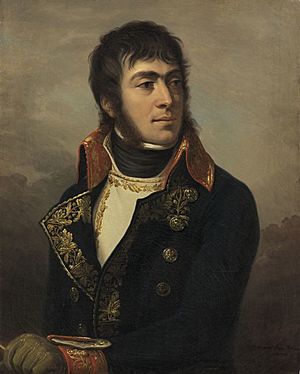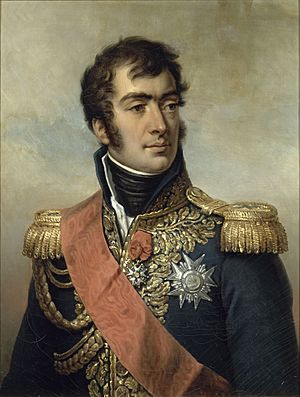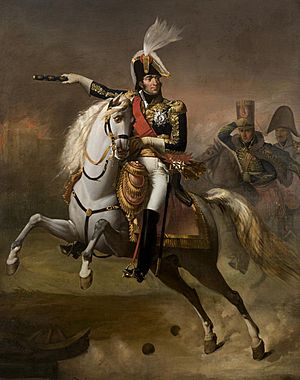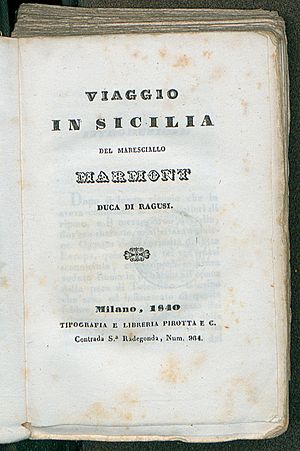Auguste de Marmont facts for kids
Quick facts for kids
Marshal of the Empire
Auguste de Marmont
Duke of Ragusa
|
|
|---|---|

Portrait by Andrea Appiani, 1798
|
|
| Born | 20 July 1774 Châtillon-sur-Seine, France |
| Died | 22 March 1852 (aged 77) Venice, Kingdom of Lombardy–Venetia |
| Allegiance | |
| Service/ |
Army |
| Rank | Marshal of the Empire |
| Battles/wars | French Revolutionary Wars, Napoleonic Wars |
| Awards | Grand Cross of the Legion of Honour |
Auguste Frédéric Louis Viesse de Marmont (born July 20, 1774 – died March 22, 1852) was a French general and a nobleman. He became a high-ranking officer called a Marshal of the Empire. He was also given the special title of Duke of Ragusa.
During the Peninsular War, Marmont took over command of the French army in northern Spain. However, he suffered a big defeat at the Battle of Salamanca.
Later, as the Napoleonic Wars ended, Marmont switched his loyalty. He joined the side of the Bourbon kings who returned to power. He stayed loyal to them even when Napoleon briefly returned during the Hundred Days. This made many people who supported Napoleon see Marmont as a traitor.
In 1830, Marmont led the royal army in Paris during the July Revolution. His efforts could not stop the revolution. King Charles X then accused Marmont of betraying the Bourbons, just as he had supposedly betrayed Napoleon. Marmont left France with the king and never came back. He spent his later years mostly in Vienna and other parts of the Austrian Empire. He died in Venice in 1852.
Contents
Early Life and Military Start
Auguste de Marmont was born in Châtillon-sur-Seine, France. His father was a former army officer from a minor noble family. Marmont loved being a soldier from a young age. His father sent him to study math to prepare for joining the artillery.
There, he met Napoleon Bonaparte. Their friendship grew stronger when Marmont served with Napoleon in Toulon. Marmont became Napoleon's aide-de-camp (a personal assistant). He stayed with Napoleon during tough times and went with him to Italy and Egypt. He fought well and was promoted to general.
In 1799, Marmont returned to Europe with Napoleon. He helped Napoleon during the coup d'état (a sudden takeover of power) of the 18 Brumaire. He also led the artillery during the expedition to Italy. His leadership was very effective at the Battle of Marengo. For this, he was quickly made a general of division. In 1801, he became a top artillery inspector. In 1804, he received a high honor, the Grand Officer of the Legion of Honour. However, he was disappointed not to be made a marshal at that time.
Fighting in the Napoleonic Wars
In 1805, Marmont was given command of a large army group. He performed well at the Battle of Ulm. After that, he was ordered to take control of Dalmatia (a region in modern-day Croatia). He occupied the Republic of Ragusa (a city-state). For the next five years, he was the military and civil governor of Dalmatia. He built many public works there, and people still remember his good rule. In 1808, he was given the title Duke of Ragusa.
During the War of the Fifth Coalition in 1809, Marmont defeated an Austrian force in Dalmatia. He then moved his army to Ljubljana. After winning another battle near Graz, Napoleon called Marmont's army to Vienna. Marmont arrived just in time to fight in the Battle of Wagram in July. During the chase after the Austrian army, Marmont's troops were in danger. Napoleon himself had to send many reinforcements to save them.
After this, Napoleon made Marmont a Marshal of the Empire. However, Napoleon privately said that Marmont had not fully earned it. French soldiers at the time joked that while other marshals were chosen by France or the army, Marmont was chosen because of friendship.
Marmont was then made governor-general of the Illyrian provinces, which included Ragusa. In May 1811, Marmont was quickly sent to Spain to replace another general. He managed to help the city of Ciudad Rodrigo even with the British army nearby. However, his movements before the Battle of Salamanca were not successful. The British commander, Wellington, attacked Marmont's army by surprise. Marmont was badly wounded in his arm and side early in the battle. Command passed to another general, and the French suffered a major defeat. Marmont returned to France to recover.
In April 1813, Napoleon again gave Marmont command of an army group. He led his troops in battles like Lützen, Bautzen, and Dresden. He then fought bravely during the defensive campaign of 1814. His forces fought a difficult retreat all the way to the final battle before Paris.
At this point, Marmont decided to take a political step. He believed the war was lost and continuing it was pointless. He secretly contacted the Allied forces. As the Allies closed in on Paris, Marmont and other marshals marched their troops to a position where they were surrounded. They then surrendered their forces.
Serving the Bourbon Kings
Marmont remained loyal to the restored Bourbon king Louis XVIII during Napoleon's brief return (the Hundred Days). After Napoleon's final defeat at Waterloo, Marmont even voted for the execution of another marshal, Marshal Ney.
He was made a Peer of France (a high-ranking noble) and a major-general of the royal guard. In 1820, he received more honors. In July 1830, during the July Revolution, Marmont was the general in charge of the guard. He was ordered to stop any resistance to the king's new laws. Even though he disagreed with the king's policies, he tried to do his duty. He only gave up when it was clear his troops were losing. This brought him even more criticism. King Charles X even ordered his arrest, asking, "Will you betray us, as you betrayed him?"
Marmont went into exile with the king and lost his marshal rank. He always wanted to return to France but never could. He traveled around central and eastern Europe. He finally settled in Vienna, where the Austrian government welcomed him. He even became a tutor to the Duke of Reichstadt, Napoleon's son.
Despite his long friendship with Napoleon, the word "raguser" (from his title, Duke of Ragusa) became a common French word meaning "to betray." Thirty years later, when he was an old man living in Venice, children would point at him and say, "There goes the man who betrayed Napoleon." He died in Venice in March 1852. He was the last living marshal from Napoleon's era.
His Writings
In his final years, Marmont spent much time writing his Mémoires (memoirs). These books are very important for understanding the military history of his time.
His other works include:
- Voyage en Hongrie (Travels in Hungary), published in 1837
- Voyage en Sicile (Travels in Sicily), published in 1838
- Esprit des institutions militaires (Spirit of Military Institutions), published in 1845
- Cesar; Xenophon; and Mémoires (8 volumes), published after his death in 1856
Family Life
In 1798, Marmont married Anne-Marie-Hortense Perregaux. Her father was a Swiss banker who helped start the Bank of France. They did not have any children and divorced in 1817. She died five years after him, in Paris in 1857.
See also
 In Spanish: Auguste Marmont para niños
In Spanish: Auguste Marmont para niños





